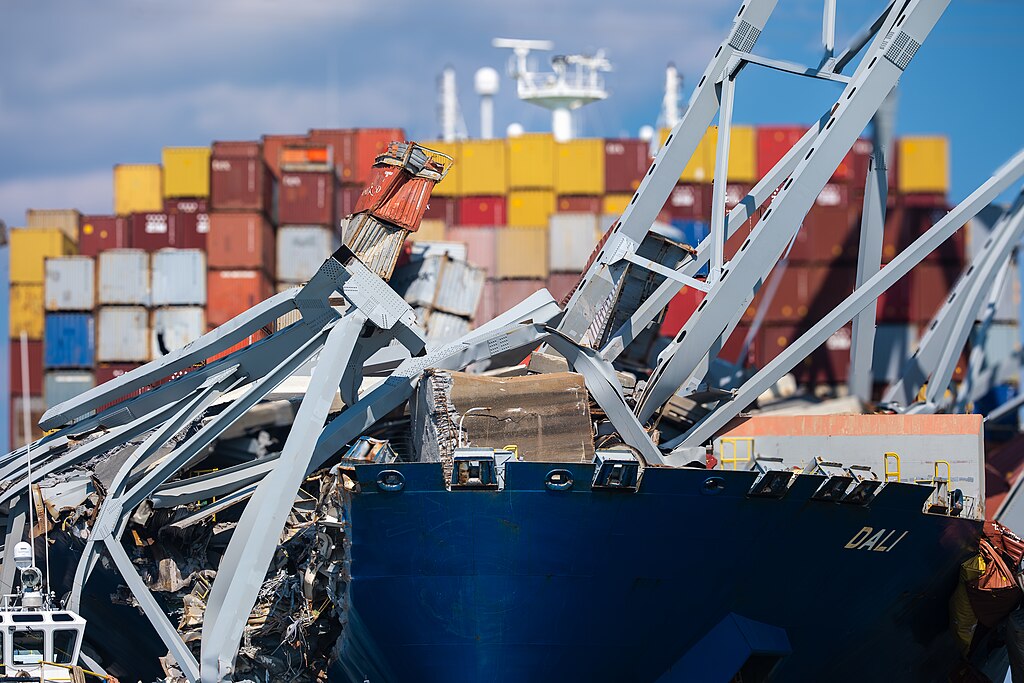The tragic collapse of the Francis Scott Key Bridge in Baltimore on March 26, 2024, transcends the realm of human loss. While the immediate focus centers on the grieving families of the six construction workers who perished, the economic repercussions of this disaster threaten to send shockwaves through the local, regional, and potentially, the national economy.
This article delves into the multifaceted impact of the bridge collapse, analyzing its consequences on the Port of Baltimore, the broader logistics industry, and the U.S. trade landscape.
A lifeline severed
The Port of Baltimore, ranked the 13th busiest in the nation in terms of cargo tonnage according to the American Association of Port Authorities (AAPA) 2023 statistics, serves as a crucial East Coast gateway for international trade. The bridge collapse effectively severed this vital artery, halting maritime traffic and jeopardizing the movement of billions of dollars’ worth of goods.
The Maryland Department of Transportation (MDOT) estimates the closure could cost the Baltimore port a staggering $15 million per day [Al Jazeera]. This translates to potential losses exceeding $450 million within a month, a significant blow to the port’s economic activity and its standing in the competitive global shipping landscape.
Beyond Baltimore – disruptions in the logistics chain
The impact extends far beyond the immediate vicinity of the collapsed bridge. The Port of Baltimore serves as a major hub for the distribution of goods throughout the East Coast and the Midwest. Disruptions caused by the closure force companies to reroute shipments, leading to:
- Increased Transportation Costs: Shifting cargo to alternative ports like Norfolk, Virginia, or Savannah, Georgia, necessitates longer distances and potentially higher transportation costs for both land and sea legs of the journey. These added expenses could be passed down to consumers in the form of higher prices for imported goods.
- Supply Chain Bottlenecks: The sudden shift in cargo movement can overwhelm alternative routes and ports, leading to congestion and delays. These bottlenecks can disrupt production schedules for manufacturers and retailers who rely on a steady flow of goods.
- Just-in-Time Inventory Challenges: Many businesses operate on a just-in-time (JIT) inventory model, minimizing storage costs by receiving goods only as needed. Disruptions caused by the bridge collapse could create shortages for companies that rely on the Port of Baltimore, potentially impacting production and sales.
National economic implications, a broader picture
The economic damage isn’t confined to Baltimore or the immediate surrounding areas. The Port of Baltimore plays a vital role in facilitating U.S. trade, particularly with Asia. According to the U.S. Census Bureau, in 2022, over $80 billion worth of goods were imported from Asia through Baltimore.
The closure disrupts these trade flows, potentially impacting:
- U.S. Trade Deficit: The rerouting of cargo could lead to increased shipping costs, potentially widening the U.S. trade deficit.
- Soybean Exports: The Port of Baltimore is a major export hub for U.S. soybeans, particularly to China. Disruptions could create uncertainty in the already volatile agricultural market.
- Consumer Confidence: Delayed deliveries and potential price hikes stemming from supply chain disruptions could erode consumer confidence, impacting overall economic activity.
The road to recovery – challenges and opportunities
The rebuilding of the bridge presents a complex logistical challenge. Estimates suggest the project could take years to complete, with significant interim costs associated with debris removal, environmental remediation, and the construction itself. The long-term economic impact hinges on several factors, including:
- Efficiency of Reconstruction: A swift and efficient reconstruction effort can minimize the economic disruption. However, navigating the bureaucratic hurdles and securing funding can be a time-consuming process.
- Alternative Routes: The effectiveness of alternative routes in handling rerouted cargo will significantly influence the severity of the economic slowdown. Upgrading infrastructure at these alternate ports could present long-term benefits.
- Government Intervention: Federal intervention through financial aid packages and streamlined permitting processes can expedite the reconstruction and mitigate the economic damage.
The bridge collapse also presents an opportunity for long-term infrastructure investment. Increased federal funding for infrastructure projects can not only expedite the reconstruction of the bridge but also address the aging infrastructure across the nation’s transportation network, potentially leading to greater economic efficiency and resilience in the long run.
A catalyst for change?
The Baltimore bridge collapse serves as a stark reminder of the interconnectedness of the global economy and the vulnerability of complex logistics chains. While the immediate economic impact is undeniable, the long-term consequences hinge on the response. A swift and efficient reconstruction effort coupled with strategic investments in infrastructure could not only minimize the damage but also catalyze positive change. The need for a robust and resilient infrastructure network across the United States has never been clearer. The Baltimore bridge collapse can serve as a turning point, prompting policymakers and businesses to prioritize infrastructure development and create a more sustainable and efficient logistics system for the future.
The coming months will be crucial in determining the true extent of the economic impact. Close monitoring of key metrics, including port activity, transportation costs, and consumer confidence, will provide valuable insights into the health of the national and regional economies.
The road to recovery will be long and arduous, but with decisive action and a focus on long-term solutions, Baltimore and the nation can emerge from this crisis stronger and more prepared for the challenges ahead.
Photo credit: Petty Officer 1st Class Brandon Giles, Public domain, via Wikimedia Commons: USCG boat approaches the wreckage of the Francis Scott Key Bridge, in Baltimore


